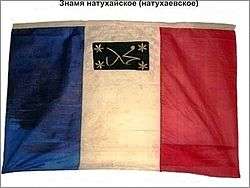Natukhai

The Natukhai (Adyghe: НатIхъуадж-адыгэ Naţḩwadź-adyge, with the possible sense нэ-тхуэ-джэ eye-white-with,'With Light Eye(s)', the /-a-/s in the name being phonologically predictable) are a people of the Adyghe branch, who are the original dwellers of the far northwest of historical Circassia. Their areas historically extended along the Black Sea coast from Anapa in the north to Tsemes Bay (now Novorossiysk) in the south and from the north side of the mountains to the lower Kuban River.
The Natukhai tribe consisted of 10 aristocratic families and 44 (Adyghe: ЛъфэкъулӀ) free clans and classified as an Adyghe democratic tribe.[1][2] Because their coast was not backed by high mountains and opened northward to the steppe the Natukhai were the most active of the Adyghe nation in trading with the Ottoman Empire and Crimean Khanate, which afforded for them better life than the other Adyghe tribes.
By culture, language and character they find themselves closest to Shapsugs of Little Shapsugia and even call themselves by the same name Aguchips. (The Lesser Shapsugs lived on the coast south of the Natukhai while the Greater Shapsugs lived north of the mountains.) Also Natukhai people include the tribe of Goaie which according to legends is the most ancient Circassian tribe. They also include the disappearing remnants of Zhane and Hegako tribes. There were at least 45 Natuhay clans. The noblest families were: Syupako, Megu, Zan, Kaz, Chakh, Eryku, Dedy. The tribe Goaie had following noble names: Kerzedzh, Kuytsuk, Khatirame, Birdzh and Cherch.
Natukhais, like Shapsugs and Abadzehs, managed to limit the power of noble men of their tribe. Their villages were also administered by elected villagers. Natukhais were one of the tribes most inclined to a peaceful sort of labor. They established trade connections with Turkey which gave Natukhai people the opportunities of material improvements. Natuhay were the last to convert to Islam. They steadily adhered to Christianity, even though religious differences were often the cause of quarrels with neighbouring Shapsugs. Only by the beginning of 19th century, whether by promises or by threats, did Turkish pasha manage to talk them into converting to Islam. In spite of that, Natukhai showed the bitterest resistance to the expansion of Russia into the Northern Caucasus. They fought shoulder to shoulder with Shapsugs and Abazdeh who by that time were on their own against the forces of Russian empire. As a result of the war, only 175 Natukhai remained on their motherland.
In late 1860, a Majlis (Adyghe: Хасэ Xase) was assembled, which would unite the Shapsugs, Ubykhs, and Natuqais and considered Sochi (Adyghe: Шъачэ; Ubykh: Шуа-чӀа, lit. "seaside") the last capital of the Circassian resistance.
In 1864, a major part of the Natukhai were massacred and the remaining forced to leave Circassia, like the other Adyghe tribes, to the Ottoman Empire due to the Russian army occupation of Circassia,[3] beside the standard tsars' policy during the era of the Russian Empire to cleanse the Circassian coast of Circassians (mainly physically then by expelling the remaining to the Ottoman Empire.[4]
Currently, Natukhai families live in the diaspora and were assimilated in other Adyghe tribes, more precisely, the Shapsugs due to their close relations with the Shapsugs. In the Caucasus a few may be found in the Republic of Adyghea (mainly in District of Takhtamukaysky in the village of Natukhai (Russian: Аул Натухай)[5] and District of Teuchezksky).
Language
The Natukhai people speak the Natukhai dialect (Adyghe: НатIхъуаджэбзэ), a dialect which is very similar to the Shapsug dialect. The Natukhai dialect shares a large number of features with other Shapsug dialects like having the consonants гь [ɡʲ], кь [kʲ], кӏь [kʲʼ] and чъу [t͡ɕʷ] that correspond to дж [d͡ʒ], ч [t͡ʃ], кӏ [t͡ʃʼ] and цу [t͡sʷ] in other Adyghe dialects (e.g. Abzakh, Temirgoy and Bzhedug).<ref name""=>Спирантизация аффрикат (Russian)</ref><ref name""=>Палатализация (смягчение) и аффрикатизация согласных (Russian)</ref>[6]<ref name""=>Наращение сонорных согласных (Russian)</ref>
| Meaning | Natukhai and Shapsug dialect | Other dialects | ||
|---|---|---|---|---|
| Cyrillic | IPA | Cyrillic | IPA | |
| fast | псыкӏэ | psət͡ʃʼa | псынкӏэ | psənt͡ʃʼa |
| wide | шъуабгъо | ʃʷaːbʁʷa | шъуамбгъо | ʃʷaːmbʁʷa |
| corn | натыф | naːtəf | нартыф | naːrtəf |
| shirt | гьанэ | ɡʲaːna | джанэ | d͡ʒaːna |
| chicken | кьэт | kʲat | чэты | t͡ʃatə |
| rope | кӏьапсэ | kʲʼaːpsa | кӏапсэ | t͡ʃʼaːpsa |
| shoe | чъуакъэ | t͡ʃʷaːqa | цуакъэ | t͡sʷaːqa |
References
- ↑ Walter Richmond , The Northwest Caucasus :Past, Present, Future, p. 22, Central Asian Studies Series, 2008 ISBN 978-0-415-77615-8
- ↑ Walter Richmond, "The Northwest Caucasus:Past Present, Future", Arabic Translation by Jameel Ishaqat, p. 46, Circassians Studies Centre, Amman, Jordan, 2010
- ↑ http://english.ruvr.ru/2010/07/05/11511062.html via the Voice of Russia
- ↑ Peter Hopkirk The great game: On Secret Service in High Asia, Chapter 12 “The Greatest Fortress in the World”, pp 158-159, Oxford University Press, 2001 ISBN 0-19-280232-1
- ↑ http://ta01.ru//index.php?option=com_content&task=view&id=12&Itemid=26 Official Website of Takhtamukasky (Russian Language)
- ↑ Переднеязычные мягкие шипящие аффрикаты дж, ч, к1 (Russian)
See also
- Circassians#Tribes
- Shapsugs
- Ethnic Cleansing of Circassians
- Bzhedug
- Abzakhs
- Zhaney
- Mamkhegh
- Temirgoy
- Hatuqwai
- Besleney